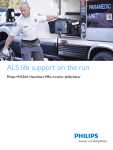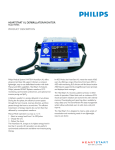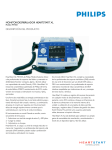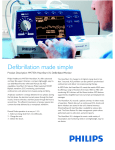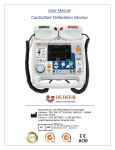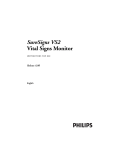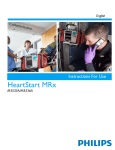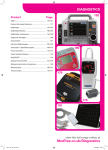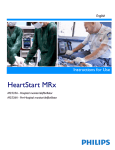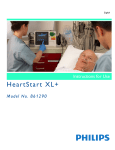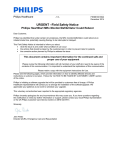Download XLR8 TDS2.fm
Transcript
Defibrillation made simple Philips 861290 HeartStart XL+ defibrillator monitor For resuscitation teams and rapid response teams, the Philips HeartStart XL+ defibrillator/monitor is designed with meaningful innovations that help you confidently and effectively respond to patients’ needs throughout the hospital environment. Hospital cardiac emergencies are often stressful and hectic events. You want a defibrillator that is dependable and ready to “grab and go” at a moment’s notice. Building on the clinical history of Philips defibrillation, the HeartStart XL+ will inspire confidence in its ability to respond in critical situations. The HeartStart XL+ offers advanced and basic life-support in a compact, light-weight and easy-to-use defibrillator/ monitor. It offers both Manual and AED defibrillation, synchronized cardioversion, and arrhythmia detection with ECG monitoring through 3- and 5-Lead sets or multifunction electrode pads. Options include SpO2 and Non-invasive blood pressure (NBP) monitoring and Pacing. The HeartStart XL+ introduces the Patient Category button. With one simple press of the Patient Category button you can switch from Adult to Infant/Child patient category. The device not only quickly and automatically adjusts the energy for AED defibrillation but it also automatically adjusts all alarm limits. AED Mode uses the same SMART Analysis algorithm as Philips’ industry-leading AEDs. In AED Mode, with the use of the patient category button, the HeartStart XL+ simplifies the ability to defibrillate different patient types without the need to calculate a dose or special pads to reduce energy. AED Mode coaches you with easy to understand voice prompts and display messages. In Manual Defibrillation Mode, defibrillation is as easy as 1, 2, 3. The entire process is under your control. After assessing the ECG you decide if defibrillation, cardioversion or pacing is necessary, select an energy, charge and shock. Select cardioversion by simply pressing 2 the Sync button. When Sync Mode is active, the Sync button lights up and indications appear on the display. In optional Pacing Mode, you can perform either Demand or Fixed mode transcutaneous pacing with a configurable choice of 20 or 40 msec pulse duration. The device also allows you to use front panel controls to adjust rate and output. The HeartStart XL+ is highly configurable such that you can configure the energy, number of shocks and CPR time to meet your hospital defibrillation protocol needs. Viewing and obtaining data from the HeartStart XL+ is easy. You can view patient parameter Trend Reports on the display. The Trend Reports and Event Summaries are also available after an event and are easily retrieved. The results of all daily, weekly and monthly self-tests and Operational Checks are stored in internal memory and available for review. Data can be copied to a USB Drive for easy transfer to event review data management software. Since it is part of a larger Philips Healthcare family of products, the HeartStart XL+ can help you simplify inventory management and reduce inventory costs. The device’s supplies and accessories are compatible with other Philips defibrillators while the patient monitoring cables and sensors are the same ones used with Philips patient monitors. The HeartStart XL+ is ready. Ready to respond. Ready to revive. Ready to review. And ready to meet the needs of your organization. Features/Upgrades Standard Features • • • • • • • • • • • • • • • • • • ST/AR Basic algorithm for arrhythmia detection and ECG analysis SMART Analysis algorithm for making shock decisions in AED Mode One button push to change from Adult to Infant/Child patient category, including alarm limits in all modes ECG monitoring through monitoring electrodes and defibrillation pads “Quick Look” ECG monitoring through external paddles Synchronized cardioversion with dedicated back-lit button Adjustable ECG size and autogain Manual and AED operation 3-wave color display Strip chart printer (50 mm) Individual, adjustable volume of QRS beeper, voice prompts and alerts Event Summary Displayed and printed Trending Reports Configuration Mode Service Mode Operational checks Automated self-tests with “Ready For Use” indicator Lithium Ion battery with fuel gauge Product Ordering Information 861290 Option Ordering Information A01 SpO2Monitoring A02 SpO2 and NBP Monitoring B01 External Pacing C01 External Paddles with PCI C02 External Paddles Sterilizable C03 USB Data Drive C04 Accessory Storage System C05 Extra Lithium Ion Battery C06 Bed Rail/Roll Stand Mounting C07 ECG Sync Out Cable C08 5-Lead ECG Cable LP1 Instructions for Use LP3 User Training DVD SM1 Service Manual W01 One-year on-site warranty W08 Three-year bench repair and loaner warranty W23 Two-year bench repair and no loaner warranty W24 Five-year bench repair and loaner warranty WA1 Five-year Biomed Alliance Optional Features • • • SpO2 with Fourier Artifact Suppression Technology (FAST) Noninvasive Blood Pressure Noninvasive Pacing HeartStart XL+ Defibrillator/Monitor Upgrades Standard Accessories 861395 SpO2 • • • • • • • • 861396 NBP 861397 External Pacing 861401 Pads Conversion 861402 External Paddles 861403 Hardware Platform 861404 Software Platform • Lithium Ion Battery with fuel gauge Hands-free multifunction electrode cable 3-Lead ECG trunk cable and lead set 10 monitoring electrodes 50mm printer paper Defibrillator Test Plug Three cable wraps (ECG, pads cable, external paddles) Documentation CD containing instructions for use, user training material and application notes Quick Reference Cards 3 Supplies Multifunction Electrode Pads 3-Lead ECG Cables M3501A Adult/Child Pads, barrel connector, AAMI M1500A 3-lead ECG Trunk Cable (AAMI) M1510A 3-lead ECG Trunk Cable (IEC) M3504A Infant Pads, barrel connector, AAMI M1605A 3-lead ECG Set with Snaps (AAMI) M3713A HeartStart Adult/Child Plus Pads M1615A 3-lead ECG Set with Snaps (IEC) M3716A HeartStart Adult/Child Radiolucent Pads M1669A 3-lead ECG Trunk Cable (AAMI/IEC) M3717A HeartStart Infant Plus Pads M1671A 3-lead ECG set grabber (AAMI/ICU) M3718A HeartStart Adult/Child Radiotransparent/Reduced Skin Irritation Pads M1672A 3-lead ECG set ICU grabber (IEC) M1673A 3-lead ECG set with snaps (ICU) M1674A 3-lead ECG set with snaps (IEC, ICU) M1675A 3-lead ECG set with grabbers (OR) M1678A 3-lead ECG set, grabber (IEC, OR) M3526A 3-wire lead set and plug, snap (AAMI) M3528A 3-wire lead set and plug, snap (IEC) M3719A HeartStart Infant Radiotransparent/ Reduced Skin Irritation Pads 989803166021 HeartStart Adult/Child Preconnect Pads 989803158211 HeartStart Adult (1 set) 989803158221 HeartStart Adult (5 sets) 989803139261 SMART Pads II Adult/Child/Infant (for handoff only) 5-Lead ECG Cables M1520A 5-lead ECG Trunk Cable (AAMI) Hands-Free Pads Therapy Cables M1530A 5-lead ECG Trunk Cable (IEC) M1625A 5-lead ECG set with snaps (AAMI) M1635A 5-lead ECG set with snaps (IEC) Defibrillator Pads Hands-Free Cable, plug style (2.2 m/7 ft.) M1644A 5-lead ICU snaps (AAMI) M1645A 5-lead ICU snaps (IEC) Pads Adapter (use with M3507A) M1668A 5-lead ECG Trunk Cable (AAMI/IEC) M3507A M3508A 05-10200 Defibrillator Pads Hands-Free Cable, barrel style (2.2 m/7 ft.) M1949A 5 plus 5 ECG Trunk Cable (AAMI/IEC) External Paddles M1968A 5-lead ICU grabber (AAMI) M3543A External Paddles M1971A 5-lead ICU grabber (IEC) M4745A Sterilizable External Paddles M1973A 5-lead OR grabber (AAMI) M4759A Paddle Electrode Replacement M1974A 5-lead OR grabber (IEC) Internal Switched Paddles 6-Lead ECG Cables M4741A 7.5cm Switched Internal Paddles M1667A 6-lead Trunk Cable (AAMI) M4742A 6.0cm Switched Internal Paddles M1680A 6-lead ICU grabber, limb (AAMI) M4743A 4.5cm Switched Internal Paddles M1682A 6-lead ICU snap, limb (AAMI) M4744A 2.8cm Switched Internal Paddles M1684A 6-lead OR grabber, limb (AAMI) Internal Switchless Paddles 10-Lead ECG Cables M1741A 7.5cm Switchless Internal Paddles M1663A 10-lead Trunk Cable (AAMI) M1742A 6.0cm Switchless Internal Paddles M1665A 10-lead Trunk Cable (AAMI) M1743A 4.5cm Switchless Internal Paddles M1682A 6-lead ICU snap, limb (AAMI) M1744A 2.8cm Switchless Internal Paddles M3525A 10-lead ECG patient Trunk Cable, 12-pin 4 ECG Monitoring Electrodes Disposable Blood Pressure Cuffs M2202A M1874A Disposable Cuff — Infant M1875A Disposable Cuff — Pediatric M1876A Disposable Cuff — Small Adult ECG Sync Out Cables M1877A Disposable Cuff — Adult M1783A 12-pin Sync Cable (8 feet) M1878A Disposable Cuff — Large Adult M5526A 12-pin Sync Cable (25 feet) M1879A Disposable Cuff — Thigh M4572B Soft Single-Patient Disposable Cuff — Infant High-Tack Foam ECG Electrodes — 5 electrodes/pack (60 packs/case) NBP Interconnect Tubing M1598B Adult Pressure Interconnect Cable (1.5m) M4573B Soft Single-Patient Disposable Cuff — Pediatric M1599B Adult Pressure Interconnect Cable (3m) M4574B Soft Single-Patient Disposable Cuff — Small Adult Reusable Blood Pressure Cuffs M4575B 40400A Reusable Cuff Kit, 3 sizes (Pediatric, Adult, Large Adult) Soft Single-Patient Disposable Cuff — Adult M4576B 40400B Reusable Cuff Kit, 5 sizes (Infant, Pediatric, Adult, Large Adult, Thigh) Soft Single-Patient Disposable Cuff — Adult X-Long M4577B 40401A Traditional Reusable Cuff — Infant Soft Single-Patient Disposable Cuff — Large Adult 40401B Traditional Reusable Cuff — Pediatric M4578B 40401C Traditional Reusable Cuff — Adult Soft Single-Patient Disposable Cuff — Large Adult X-Long 40401D Traditional Reusable Cuff — Large Adult M4579B 40401E Traditional Reusable Cuff — Thigh Soft Single-Patient Disposable Cuff — Thigh M4552B Easy Care Reusable Cuff — Infant M4553B Easy Care Reusable Cuff — Pediatric M4554B Easy Care Reusable Cuff — Small Adult M4555B Easy Care Reusable Cuff — Adult M4556B Easy Care Reusable Cuff — Adult Long M4557B Easy Care Reusable Cuff — Large Adult M4558B Easy Care Reusable Cuff — Large Adult X-Long M4559B Easy Care Reusable Cuff — Thigh M1571A Multi-Patient Comfort Cuffs — Infant M1572A Multi-Patient Comfort Cuffs — Pediatric M1573A Multi-Patient Comfort Cuffs — Small Adult M1574A Multi-Patient Comfort Cuffs — Adult M1575A Multi-Patient Comfort Cuffs — Large Adult M1576A Multi-Patient Comfort Cuffs — Thigh 5 SpO2 Data Management M1131A Disposable SpO2 Sensor — Adult/ Pediatric Finger 989803171261 USB Data Drive M1132A Disposable SpO2 Sensor — Pediatric Accessory Pouches M1133A Disposable SpO2 Sensor — Neonatal/ Adult (for adults only - any finger except thumb) 989803171281 One therapy and one monitoring accessory system M1191A Reusable SpO2 Sensor — Adult finger M1191B Reusable SpO2 Sensor — Adult finger 989803171291 Three cable wraps (one each for ECG, hands-free therapy cable, external paddles) M1191AL Reusable SpO2 Sensor — Adult finger (3m cable) Mounting Solutions M1191BL Reusable SpO2 Sensor — Adult finger (3m cable) M1191T Reusable SpO2 Sensor — Adult finger (9-pin connector) M1192A Reusable SpO2 Sensor — Pediatric/Small Adult M1192T Reusable SpO2 Sensor — Pediatric Finger (9-pin connector) M1194A Reusable SpO2 Sensor — Adult/Pediatric ear clip M1195A Reusable SpO2 Sensor — Infant M1196A Reusable SpO2 Sensor — Adult clip M1196T Reusable SpO2 Sensor — Adult clip (9-pin connector) M1902B Disposable SpO2 Sensor — Infant digit (available outside the U.S. only) Adapters M4740A For use with internal switchless paddles M1903B Disposable SpO2 Sensor — Pediatric Finger (available outside the U.S. only) 05-10200 M1904B Disposable SpO2 Sensor — Adult Finger (available outside the U.S. only) For M3507A. Changes barrel cable to flat (removable or permanent) for M37xxA pads M1941A SpO2 Extension Cable (2m) Paper M1943A Reusable SpO2 Sensor Adapter Cable (1m) — Use with M1903B/M1904B 40457C 50 mm Chemical Thermal Paper, gray grid (10 rolls) M1943AL Reusable SpO2 Sensor Adapter Cable 40457D 50 mm Chemical Thermal Paper, gray grid (50 rolls) Power 989803167281 HeartStart XL+ Lithium Ion Battery 6 989803171701 Bed Rail/Roll Stand Hook PH-0050-60 GCX Roll Stand with basket (orderable through GCX) PH-0050-03 GCX Flush Wall Mount (orderable through GCX) Test Loads and Test Plugs M1781A Test Load for use with M3507A Pad Cable M3725A Test Load for use with M3508A Pad Cable 989803171271 Defibrillator Test Plug for M3508A Cable Specifications Physical Dimensions Defibrillator Size: inches: 11.6W x 9H x 10.9D cm: 29.6W x 23H x 27.9D Waveform: Weight: 14.7 lbs/6.6 kg (includes one battery, one new roll of paper, one pads cable). Incremental weight of external standard paddles and paddle tray is less than 3 lbs (1.3 kg). Biphasic Truncated Exponential. Waveform parameters adjusted as a function of patient impedance. Shock Delivery: Via multifunction electrode pads or paddles. Shock Series: Configurable energy escalation in a series. Standard Operator Position: Within one meter (3 feet) of the device. Power Supply Leads Off Apply 500nA rms (571Hz); 200uA rms sensing and (32KHz). PCI sensing for pads/paddles: Charge time: Rechargeable Lithium Ion battery; AC power using a protectively grounded outlet. 3 seconds to the recommended adult energy level (150 Joules) with a new fully-charged battery installed. Less than 5 seconds to the selected energy level (up to 200 Joules) with a new fully charged battery installed. Alarms Alarm Tone Maximum - 85 dB(A), and Voice Minimum - 45 dB(A). Message Volume Range: Less than 15 seconds to the selected energy level while connected to AC power only. Alarm Tone Volumes Imminent Shutdown: Continuous tone alternating between 1000 and 2100 Hz. High Priority: Tone of 960 Hz lasting 0.5 sec repeated every second. Medium Priority: Tone of 480 Hz lasting 1 sec repeated every two seconds. Low Priority: Tone of 960 Hz lasting 0.25 sec repeated every two seconds. The device powers on in manual defibrillation mode ready to deliver shock in less than 8 seconds plus applicable charge time, assuming an immediate selection of an energy and initiation of a charge, even at 90V AC and after 15 maximum energy discharges. The device powers on in AED mode ready to deliver shock in less than 17 seconds plus applicable charge time. Alarm Characteristics High Priority: Flashing at 2 Hz with 50% duty cycle (a .25-sec flash twice every second). Medium Priority: Flashing at 0.5 Hz with 50% duty cycle (a 1-sec flash every other second). Low Priority: Constant on. Patient Impedance Range: Minimum: 25 ohm (external defibrillation); 15 ohm (internal defibrillation); Maximum: 250 ohm. Actual functional range may exceed these values. 7 Delivered Energy Accuracy Manual Defibrillation Manual Output 1-10, 15, 20, 30, 50, 70, 100, 120, 150, Energy 170, 200 Joules; maximum energy limited (Selected): to 50J with internal paddles. Nominal Delivered Energy vs. Load Impedance Energy Load Impedance (ohms) ± 2% 25 50 75 100 125 150 175 1J 1.2 1.3 1.3 1.2 1.1 1.0 0.9 2J 1.7 2.0 2.1 2.0 1.9 1.7 1.6 3J 2.6 3.0 3.1 3.2 3.2 3.1 2.9 4J 3.5 4.0 4.2 4.3 4.4 4.5 4.3 5J 4.3 5.0 5.2 5.4 5.5 5.6 5.4 6J 5.2 6.0 6.3 6.5 6.6 6.7 6.5 7J 6.1 7.0 7.3 7.6 7.8 7.8 7.6 8J 6.9 8.0 8.4 8.6 8.9 8.9 8.7 9J 7.8 9.0 9.4 9.7 10 10 9.8 10 J 8.7 10 10 11 11 11 11 15 J 13 15 16 16 17 17 16 20 J 17 20 21 22 22 22 22 30 J 26 30 31 32 33 33 33 50 J 43 50 52 54 55 56 54 70 J 61 70 73 76 78 78 76 100 J 87 100 105 108 111 111 108 120 J 104 120 126 130 133 134 130 150 J 130 150 157 162 166 167 163 170 J 147 170 178 184 188 189 184 200 J 173 200 209 216 222 223 217 Delivered Energy accuracy is ±10% or ±1J whichever is greater for all energy settings. Smart Biphasic Waveform at 200J into 25-175 Ohms 2500 2000 Voltage (V) 1500 1000 500 0 -500 -1000 -1500 0 5 10 Time (ms) 8 15 20 Controls: On/Off Therapy knob, Charge, Shock, Sync, ECG Lead Select, Patient Selection, Print, Mark Events, Reports, Alarms, Menu Select, Navigation. Energy Selection: Front panel Therapy knob. Charge Control: Front panel button; button on external paddles. Shock Control: Front panel button; buttons on external or switched internal paddles. Synchronized Control: Front panel Sync button. Synchronized Shock Timing: Maximum time from R-Wave detected to shock delivered is 25ms, as measured with oscilloscope from peak of input QRS wave to leading edge of defibrillation discharge into a 50 ohm test load. Indicators: Text prompts, audio alerts, QRS beeper, battery status, Ready For Use (RFU), External Power, Sync Mode. Armed Indicators: Charging/charged tones, flashing shock button on front of panel and on external paddles, energy level indicated on the display. AED Mode AED Energy Profile: ECG and Arrhythmia Monitoring 150 Joules for Adult/50 Joules for Infant/ Child (factory default) nominal into a 50 ohm test load. Inputs: Up to 3 ECG waves may be viewed on the display and up to 2 waves printed simultaneously. Lead I, II or III is obtained through the 3-wire ECG cable and separate monitoring electrodes. With a 5-Lead ECG cable, leads aVR, aVL, aVF and V can also be obtained. Pads ECG is obtained through two multifunction electrode pads. Lead Fault: Messages and dashed lines appear on the display if an electrode or lead becomes disconnected. Pad Fault: Dashed line appears on the display if a pad becomes disconnected. Heart Rate Display: Digital readout on the display from 16 to 300 bpm (Adult Patient Category) or 16 to 350 bpm (Infant/Child), with an accuracy of ±10% or ±5 bpm whichever is greater. Heart Rate/ Arrhythmia Alarms: HR high/low, Asystole, VFIB/V-TACH, VTACH, Extreme Tachy, Extreme Brady, PVC rate, Pacer Not Capture, Pacer Not Pacing. Common Mode Rejection: 105 dB for Leads ECG, 96 dB for pads ECG. ECG Size: 1/4x, 1/2x, 1x, 2x, 4x, auto gain (1x gain is 10mm/mV on the printed strip). ECG waveforms: Displayed at a fixed timebase of 25 mm/ sec (printer) ±5%, 20 mm/sec (display) ±10%. AED Controls: On/Off, shock. Text and Voice Extensive text/audible messages guide Prompts: user through a user-configured protocol. Indicators: Monitor display messages and prompts, voice prompts, battery status, RFU, external power. Armed Indicators: Charging/charged tones, flashing shock button, energy level indicated on the display. ECG analysis: Evaluates patient ECG and signal quality to determine if a shock is appropriate and evaluates connection impedance for proper defibrillation pad contact. Shockable Rhythms: Shock Advisory Algorithm Sensitivity: Shock Advisory Algorithm Specificity: SMART Analysis is designed to shock ventricular fibrillation, ventricular flutter and polymorphic ventricular tachycardia. It is designed to avoid delivering a shock for rhythms that are commonly accompanied by a pulse or rhythms that would not benefit from an electrical shock. Meets AAMI DF39 requirements and AHA recommendations; Adult: Ventricular Fibrillation - 90% with lower confidence limit (LCL) of 87 %, Polymorphic Ventricular Tachycardia and Ventricular Flutter - 75% with LCL of 67 %; Infant/Child: Ventricular Fibrillation - 90% with LCL of 87 %. Meets AAMI DF39 requirements and AHA recommendations; Normal Sinus Rhythm - 99% with LCL of 97%; Asystole - 95% with LCL of 92%; Other nonshockable Rhythms - 95% with LCL of 88%. ECG Leads Off 3- and 5-Lead wires apply a 30nA DC Sensing: current. Maximum T-Wave amplitude: Device rejects up to 80% of R-Wave amplitude for synchronized cardioversion; up to 55% of R-Wave amplitude for demand pacing; up to 34% of R-Wave amplitude for arrhythmia analysis. Frequency Response: ECG AC Line Filter - 50 Hz or 60 Hz; ECG for Display - 0.15-40 Hz, 0.05-40 Hz; ECG for Printer - 0.05-150 Hz Diagnostic, 0.15-40 Hz, 0.05-40 Hz. 9 ECG and Arrhythmia Monitoring ECG and Arrhythmia Monitoring Heart rate accuracy and response to irregular rhythm: Meets AAMI standard for ventricular bigeminy (HR = 80 bpm); slow alternating ventricular bigeminy (HR=60 bpm); rapid alternating ventricular bigeminy (HR=120 bpm); bidirectional systoles (HR=90 bpm) as measured after a 20 sec stabilization time. Patient Isolation (Defibrillation Proof): Lead ECG, SpO2, NBP and Internal Paddles: Type CF Other consideration: Heart rate averaging: For heart rates 50 bpm, heart rate is determined by averaging the 12 most recent R-R intervals. Beats N, P, and V are included. When heart rate drops below 50 bpm, the four most recent R-R intervals are used in the average. Note: For ventricular tachycardia alarms, which have a user-definable PVC run length limit, the heart rate is based on the userselected PVC length up to 9 PVCs maximum. The HeartStart XL+ is suitable for use in the presence of electrosurgery. Burn hazard protection is provided via a 1K current-limiting resistor contained in each ECG lead wire. Proper lead placement is important to reduce burn hazards in the event of a defect in the electrosurgical equipment. Pace Pulse Detection Sensitivity: 1 mV for a width of 100 µs; 200 µV for a 500 µs width and 200 µV for widths of 500 µs to 2 ms. ECG Analog Output Bandwidth: 0.5 to 70 Hz ECG Analog Output Gain: 1v output per 1mV input ±10% ECG Analog Output Delay: Propagation delay time is <35ms from ECG input to ECG analog output. Pacemaker Pulse Rejection Capability: Amplitude from ± 2 mV to ± 700 mV, width from 0.1 ms to 2.0 ms as per ANSI/AAMI EC 13: 2002 4.1.4.1. Heart Rate Response Time: 7 sec (80-120 bpm); 6 sec (80 to 40 bpm) Time to Alarm 3 sec for 206 bpm (1 mV, halved for amplitude and double amplitude) and Tachycardia: 195 bpm (2 mV, halved amplitude and double amplitude) as measured following a normal 80 bpm rate with upper alarm limit set at 100 and lower alarm limit set at 60 bpm. 10 Pads/Paddles: Type BF Battery Type: Rechargeable, Lithium Ion; See battery label for capacity information. Dimensions: 23.6mm (H) x 116mm (W) x 146 mm (L); 1 in (H) x 4.5 in (W) x 5.7 in (L) Weight: Approximately .68kg (1.5 lbs) Charge time with device turned off and AC power connected: With the temperature between 0-35° C (32-95° F), less than 3 hours to 100% capacity; less than 2 hours to 80% capacity. Charge time Charge time is less than 10 hours. with device on and AC power connected Life: Depends on frequency and duration of use. When properly cared for and used in its intended environment, the useful life is approximately 3 years. Use outside those conditions can significantly reduce battery life. Battery Capacity: Battery Indicators: Battery Storage: Pacing With a new fully charged battery, at 20 °C (68 °F), one of the following: At least 3 hours of monitoring (ECG and SpO2 monitored continuously and NBP sampled every 15 minutes) followed by 20 full-energy charge/shocks; OR at least two hours of pacing (180ppm at 140mA with 40 msec pulse width) while monitoring (ECG and SpO2 monitored continuously and NBP sampled every 15 minutes) followed by 20 full-energy charge/shocks; OR at least 175 fullenergy charge/shocks. Battery gauge on battery, capacity indicator on display, power indicators on front of device; flashing RFU indicator, chirp and Low Battery messages on the display for low battery condition. When a low battery message first appears there is still enough energy for at least 10 minutes of monitoring and 6 maximum energy discharges. Storing the battery for extended periods at temperatures above 40° C (104° F) reduces battery capacity and degrades battery life. Waveform: Monophasic. Current Pulse Amplitude: 10 mA to 200 mA if the pulse width is set to 20ms (5 mA increments); accuracy ±10% or ±5 mA whichever is greater. For a 40ms setting, the maximum pacing current is 140mA. Pulse Duration: 20 or 40 msec with ±10% accuracy. Rate: 30 ppm to 180 ppm (10 ppm increments); accuracy ±1.5% Mode: Demand or Fixed. Refractory Period: 340 msec (30 to 80ppm); 240 msec (90 to 180 ppm) ±10%. SpO2 Measurement Range: 0-100% Resolution: 1% Update Period: 1-2 sec typical; maximum of 30 sec Ambient Light Sensitivity: Interference from fluorescent light is <2% SpO2 under the following conditions: 0.3 and 1% perfusion, 50 nA/ mA transmission, 10 to 1000 lx light intensity, 50/60Hz power line frequency ±0.5 Hz line frequency. Alarm Range: Low Limit: 50-99% (Adult and Infant/ Child); High Limit: 51-100% (Adult and Infant/Child) Printer Continuous ECG Strip: The Print key starts and stops the strip. The printer can be configured to be run real time or with a 10-second delay. The strip prints the primary ECG lead and a second wave with event annotations and measurements. SpO2 and Pulse 10 seconds High/Low Alarm Signal Generation Delay: Auto Printing: The printer can be configured to automatically print on Mark Events, Charge, Shock and Alarm. Response Average 18.9 seconds, standard Time (90 to 80 deviation 0.88 seconds %): Reports: The following can be printed: Event Summary (Long or Short), Vital Signs Trends, Operational Check, Configuration, Status Log, Device Information. SpO2 and Pulse 10 sec Averaging Time: Speed: 25 mm/s with an accuracy of ±5%. Amplitude Accuracy: 5% for offset voltages of ± 300 mV at 5Hz. Paper Size: 50 mm (W) x 30 m (L) Emitted Light Energy: 15 mW Wavelength Range: 500-1000 nm (Information about wavelength range can be useful to clinicians, especially those performing photodynamic therapy.) 11 SpO2 NBP Desat Alarm Signal Generation Delay: 20 sec Mean Alarm Range High: Adult: 30-220 mmHg/4-30 kPa; Infant/Child: 30-135 mmHg/4-18 kPa Mean Alarm Range Low: Adult: 25-215 mmHg/3-29 kPa; Infant/Child: 25-130 mmHg/3-17 kPa Pulse Rate Measurement Range: 30-300 bpm Pulse Rate Range: 30 to 220 bpm Pulse Rate Resolution: 5 bpm Initial Pressure: 160 mmHg, 21 kPa (adult); 120 mmHg, 16 kPa (Infant/Child); 2% or 1 bpm whichever is greater Maximum Pressure: 300 mmHg; 40 kPa Pulse Rate Accuracy: Average 18.0 seconds, standard deviation 0.86 seconds. Overpressure Safety Limits: 300 mmHg; 40 kPa Pulse Response Time (90 to 120 bpm): Cuff Inflation Time: 75 sec maximum Pulse Alarm Range: Low Limit: 30-295 (Adult and Infant/ Child); High Limit: 35-300 (Adult and Infant/Child) Pressure Transducer Accuracy: ±3 mmHg over the range 1-300 mmHg/ .1-40 kPa Auto Mode Repetition Time: 1, 2.5, 5, 10, 15, 30, 60 or 120 min Maximum Measurement Time: 120 sec Interconnect Tube Length: M1598B Connect tubing 1.5 m (4.92 ft.); M1599B Connect tubing 3.0 m (9.24 ft.) Accuracy with sensors (1 standard deviation 70-100%): ± 2%: ± 3%: M1132A, M1133A, M1191A, M1191B, M1191AL, M1191BL, M1192A. M1131A, M1191T, M1192T, M1194A, M1195A, M1196A, M1196T, M1902B, M1903B, M1904B. NBP Systolic Pressure Range: Adult: 40-260 mmHg/5-35 kPa; Infant/Child: 40-160 mmHg/5-21 kPa Diastolic Pressure Range: Adult: 20-200 mmHg/2-27 kPa; Infant/Child: 20-120 mmHg/2-16 kPa Recommended Yearly Frequency of Pressure Transducer Calibration: Display Mean Pressure Adult: 26-220 mmHg/3-30 kPa; Range: Infant/Child: 26-133 mmHg/3-18 kPa Size: Approximately 6.5 in (16.5 cm) diagonal viewing area. Systolic Alarm Range High: Adult: 45-260 mmHg/6-35 kPa; Infant/Child: 45-160 mmHg/6-22 kPa Type: Color TFT LCD Systolic Alarm Range Low: Adult: 40-255 mmHg/5-34 kPa; Infant/Child: 40-155 mmHg/5-21 kPa Resolution: 640 x 480 pixels (VGA) with 32 brightness levels per color Diastolic Alarm Range High: Adult: 25-200 mmHg/3-27 kPa; Infant/Child: 25-120 mmHg/3-16 kPa Sweep Speed: 20 mm/s nominal (stationary trace; sweeping erase bar) for ECG and SpO2 Diastolic Alarm Range Low: Adult: 20-195 mmHg/2-26 kPa; Infant/Child: 20-115 mmHg/2-15 kPa 12 Wave Viewing 5.2 sec Time: Environmental Environmental Temperature: 0°C to 45°C (32°F to 113°F) operating; 20°C to 70°C (-4°F to 158°F) storage Humidity: Up to 95% relative humidity Vibration Operating Random: Atmospheric Pressure Range: Operating and Storage - 1014 mbar to 572 mbar (0 to 15,000 ft; 0 to 4,500 m) Frequency: 10-100, PSD (m/s2)2/Hz 1.0 Frequency: 100-200, Slope (dB/octave): -3.0 Frequency: 200-2000, PSD 0.5 Frequency: 10-57, Amplitude ± .15 mm; Frequency: 57-150, Amplitude 2g Shock operating: Half-sine waveform, duration 11ms, acceleration 15.3 G, 3 shocks per face Vibration NonOperating Swept Sine Shock non-operating Trapezoidal waveform, acceleration 30G, velocity change 7.42 m/s ±10% 1 shock per face Frequency: 5-500 Hz, PSD: 0.0117 g2/Hz, Acceleration: ~ 2.41 Grms Water/Solids Ingress Resistance: Meets Ingress Protection level IP21 Vibration NonOperating Random: EMC: Complies with the requirements of standard EN 60601-1-2:2002 Safety: Meets UL 60601-1 (1st edition), EN 60601-2-4:2003, EN 60601-1:1990 Mode of Operation: Continuous AC Line Powered: 100-240 VAC, 50 or 60 Hz, 1-0.46A, Class I Equipment Battery Powered: Minimum 14.4 V, Rechargeable Lithium Ion Patient Data Storage Internal Event Summary: The Internal Event Summary stores up to 8 hours of data per event. The number of events that can be stored is related to the duration of each individual event. USB Device Correct Drive: Use the USB Drive that accompanied your device. If it is not available, use a USB device that is USB 2.0 compatible and is 32 gigabytes. Other The HeartStart XL+ is not suitable for considerations: use in the presence of concentrated oxygen or a flammable anesthetic mixture with air, oxygen. or nitrous oxide. Hazards arising from software errors were minimized by the product’s compliance with the software requirements contained in EN 60601-14:1996. 13 Philips Healthcare is part of Royal Philips Electronics How to reach us www.philips.com/healthcare [email protected] Asia +49 7031 463 2254 Europe, Middle East, and Africa +49 7031 463 2254 Latin America +55 11 2125 0744 North America +1 425 487 7000 800 285 5585 (toll free, US only) Trademarks and trade names are those of their respective owners. Please visit www.philips.com/heartstart © 2011 Koninklijke Philips Electronics N.V. All rights are reserved. Philips Healthcare reserves the right to make changes in specifications or to discontinue any product at any time without notice or obligation and will not be liable for any consequences resulting from the use of this publication. Printed in The Netherlands. 4522 962 71361 * JUL 2011














